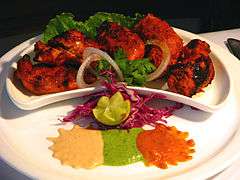Appam
|
Appam | |
| Alternative names | Hoppers, Ãppa, kallappam, palappam |
|---|---|
| Type | Pancake or griddle cake |
| Course | Breakfast or dinner |
| Main ingredients | Rice batter |
| Variations | Egg hoppers |
|
| |
Appam is a type of pancake made with fermented rice batter and coconut milk. It is a common food in the South Indian state of Kerala.[1][2][3][4][5] It is also popular in Tamil Nadu and Sri Lanka.[6] It is eaten most frequently for breakfast or dinner.
It is considered as a staple diet and a cultural synonym of the Nasranis (also known as Saint Thomas Christians or Syrian Christians) of Kerala.[2][3][4][7][8] According to Gil Marks, each of the three separate Indian Jewish communities - Cochin, Mumbai, Calcutta - counts in its culinary repertoire grain dishes called appam.[9]
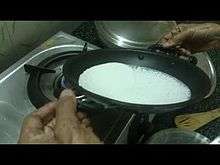
History
Vir Sanghvi, an Indian journalist, quotes food historian K. T. Achaya and states that the appam is mentioned in the Tamil Perumpanuru.[5][10][11] K. T. Achaya in the last published book of his lifetime states that Appam was well established in ancient Tamil country (comprising most parts of present-day South India), as per references in the Perumpanuru.[11] Appam first emerged in the southern tip of India, as per Gil Marks.[9]
Regional names
It is called aappam (ஆப்பம்) in Tamil, appam (അപ്പം) in Malayalam, appa (ආප්ප) in Sinhala, chitau pitha (ଚିତାଉ) in Oriya, paddu or gulle eriyappa in Kodava, and arpone (အာပုံမုန့်) in Burmese. Appam is commonly referred to by its anglicized name, hoppers, in Sri Lanka. In Indonesia it is known as kue apem.
Variations
Plain Appam
Plain Appam or Vella Appam are bowl-shaped thin pancakes made from fermented rice flour. They derive their shape from the small appachatti in which they are cooked. They are fairly neutral in taste and mostly served with some spicy condiment or curry. These hoppers are made from a batter using rice, yeast, salt and a little sugar. After the mixture has stood for a couple of hours, it can be fried in the appachatti with a little oil. In south-central Kerala, it is mostly served with kadala curry, mutton or vegetable stew or egg roast.
Palappam
Palappam is prepared using a spoonful of thick coconut milk/coconut cream added to the doughy centre. When cooked, the centre is firm to the touch but remains soft inside and is sweeter as a result of the coconut milk.
Kallappam
It is a form of appam where kallu is added to the fresh batter to kick start the fermentation. It might also denote appam cooked on a griddle (kal) instead of appachatti.
Egg hoppers
They are same as plain hoppers, but an egg is broken into the pancake as it cooks
Honey hoppers
Honey hoppers are crispy pancakes cooked with a generous amount of palm treacle. Some people also like to add some jaggery just before serving to make it extra sweet.
Idiyappam
Idiyappam (string hopper or noolputtu) is made from rice noodles curled into flat spirals. It is served for breakfast with a thin fish or chicken curry, containing only one or two pieces of meat, a dhal (lentil) dish, and a spicy sambol or fresh chutney. String hoppers are made from steamed rice flour made into a dough with water and a little salt, and forced through a mould similar to those used for pasta to make the strings. They are cooked by steaming. These hoppers can be bought ready-made. The Indian and Sri Lankan population eats string hoppers for breakfast or dinner. There are many variations to this, depending on the type of flour used etc. This simple dish can be adapted into other foods such as string hopper Biriyani, by adding scrambled eggs or vegetables.[12] Another example is located in Kerala, 'Idiyappam' Paaya (goat leg soup made using coconut).
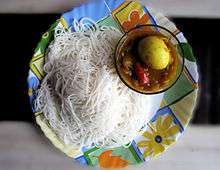
Achappam
Achappam is a deep fried rose cookie made with rice. It is a signature Syrian Christian food as per K. T. Achaya.[13]
Kuzhalappam
Kuzhalappam is a typical Syrian Christian dish which is a fried crisp curled up like a tube.[1]
Neyyappam
Neyyappam owes its origins to Kerala and is a signature food of Syrian Christians of Kerala, as per K. T. Achaya.[13] It is made with rice flour, jaggery, clarified butter ghee.
Unni appam is a variation in which mashed plantain is added to the batter. The batter is made out of rice flour, jaggery and plantain is poured into a vessel called appakarai or appakaram, which has ghee heated to a high temperature. The appams take the shape of small cups and are fried until deep brown. Both neyyappam and unni appam are eaten as snacks.
Pesaha appam
Pesaha appam is made by Nasrani Christians in Kerala during Pesaha (Passover). This type of appam is dipped in syrup or Pesaha Pal (Passover Coconut Milk) before being served.[14]
Vattayappam
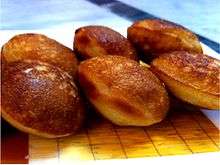
Vattayappam is made from rice flour, sugar, and coconut. The dish is made by steam-cooking the batter, and is very similar to the bánh bò from Vietnam.
Kandarappam
Kandarappam, is a sweet dish made using rice and all 4 dals and jaggery. The dish has all the ingredients that is considered to bring good luck in Hindu tradition. Using all 4 dals is considered auspicious during festivals.
Kue apem
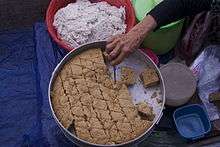
In Indonesia, a variant of appam is known as kue apem or kue apam. It is an Indonesian kue or traditional cake of steamed dough made of rice flour, coconut milk, yeast and palm sugar, usually served with grated coconut.[15] It is quite similar to kue mangkok. Just like kue putu it is derived from Indian influence on Indonesian cuisine.
See also
References
- 1 2 K.T. Achaya (1997). Indian Food: A Historical Companion. Oxford University Press. ISBN 0195644166.
- 1 2 Vijayan Kannampilly (2003). The Essential Kerala Cookbook. Penguin Books India. pp. 13, 14, 187. ISBN 0143029509.
- 1 2 Martin Hughes; Sheema Mookherjee; Richard Delacy (2001). India, Lonely Planet World Food Guides, World Food Series. Lonely Planet. p. 201. ISBN 1864503289.
- 1 2 "Rahul Gandhi has traditional Syrian Christian meal in Kerala". India Today. 13 January 2014.
- 1 2 Vir Sanghvi (2004). Rude Food: The Collected Food Writings of Vir Sanghvi. Penguin Books India. p. 110. ISBN 0143031392.
- ↑ "12 Sri Lanka foods visitors have to try". CNN.
- ↑ "Exploring Cuisine From India's Spice Coast". The New York Times. 13 September 2000.
- ↑ "Christmas with a Suriyani twist". Deccan Chronicle. 15 December 2013.
- 1 2 Marks, Gil (2010). Encyclopedia of Jewish food. Hoboken, N.J.: Wiley. ISBN 0544186311.
- ↑ Subhadra Sen Gupta (2012). Let's Go Time Travelling. Penguin UK. ISBN 818475678X.
- 1 2 K. T. Achaya. The Story of Our Food. Universities Press. p. 80. ISBN 81-7371-293-X.
- ↑ Petrina Verma Sarkar (2011-03-02). "Appams - Appam Recipe - Hoppers - Hoppers Recipe". Indianfood.about.com. Retrieved 2011-11-21.
- 1 2 "Times of India food article from Apr 10,2010". Times Of India.
- ↑ Amprayil, Kuruvilla Cherian (16 March 2008). "Kerala Nazranee Pesaha Receipes". Nasrani Syrian Christians Network. Retrieved 22 August 2009.
- ↑ "Kue Apem Kukus" (in Indonesian). Sajian Sedap. 16 December 2010. Retrieved 25 June 2015.
External links
- Traditional Appam Recipe
- Coconut Appam Recipe
- Kerala Style Appam Recipe (Rice and coconut pancake)
- Appam:Hoppers – Jaffna Tamil Recipe
- STRING HOPPER MAKER 2008 Thayabi Products Inc
- Nadia Chitau Pitha of orissa & more
- www.foodandwine.com/ Pal Appam Recipe – Maya Kaimal
- Pesaha/Indri Appam and Paal – mariasmenu.com
- Breakfast Pleasures on a Weekend Morning – flickr.com
- Suriani Kitchen by Lathika George (Recipes and recollections from the Syrian Christians of Kerala)


